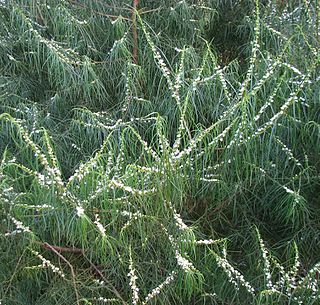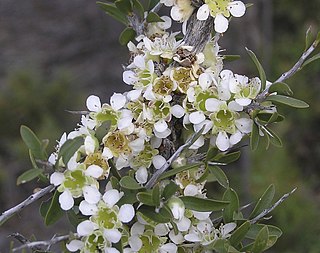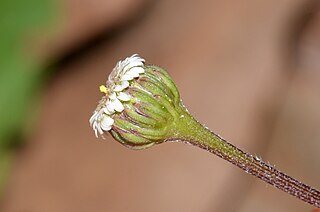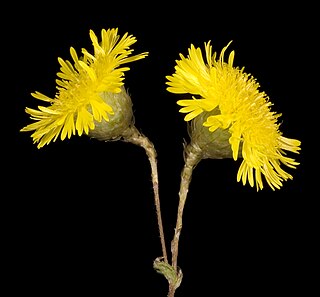
Hibbertia stellaris, commonly known as star guinea flower or orange stars, is a brilliantly orange flowering ground cover from the South Western Australian botanical province. It naturally grows in swamps; despite this, it is extremely sensitive to phytophthora and needs to be grown in well-drained soil in cultivation.

Chorilaena quercifolia, commonly known as karri oak or chorilaena, is a species of bushy shrub that is endemic to the karri forests of south-west Western Australia. It is the sole species in the genus Chorilaena. It has papery, broadly egg-shaped leaves with lobed edges and variously-coloured flowers arranged in umbels of five, the sepals and petals hairy on the outside and the stamens protruding beyond the petals.

Darwinia citriodora, commonly known as lemon-scented darwinia or lemon scented myrtle, is a plant in the myrtle family Myrtaceae and is endemic to the south-west of Western Australia. It is a shrub with oblong to lance-shaped leaves and red, yellow and orange flowers over an extended period. It is a hardy plant in well-drained soil, is often cultivated and used as a rootstock for less hardy species.

Eremophila deserti is a shrub which is endemic to Australia. Common names for this species include turkey bush, dogwood, poison bushEllangowan poison bush, pencil bush and carrot bush. It is common and widespread in all mainland states, although not the Northern Territory. Some forms are poisonous to stock.
Enumeratio plantarum quas in Novae Hollandiæ ora austro-occidentali ad fluvium Cygnorum et in sinu Regis Georgii collegit Carolus Liber Baro de Hügel is a description of the plants collected at the Swan River colony and King George Sound in Western Australia. The author, Stephan Endlicher, used a collection arranged by Charles von Hügel to compile the first flora for the new settlements. Hugel visited the region during 1833–1834, several years after the founding of the colony. The work provided formal descriptions, in Latin, of new species and genera of plants. The single instalment was produced in Europe by Endlicher in 1837, the work also included contributions by Eduard Fenzl, George Bentham, Heinrich Wilhelm Schott.

Myoporum floribundum, commonly known as weeping myoporum or slender myoporum, is a sour-smelling glabrous shrub in the family Scrophulariaceae endemic to a small area of New South Wales and Victoria in Australia. It has long, thin, drooping leaves and profuse white flowers in clusters along the stems in spring. Although it is uncommon in nature, it has long been available as a popular garden plant.

Eutaxia parvifolia is a species of flowering plant in the family Fabaceae and is endemic to southwestern Western Australia. It is a shrub with reddish brown stems, elliptic to egg-shaped leaves with the narrower end towards the base, and mostly yellow, red or orange flowers, with yellow red or orange markings.

Acacia huegelii is a shrub belonging to the genus Acacia and the subgenus Phyllodineae native to Western Australia.

Leptospermum spinescens, commonly known as the spiny tea tree, is a species of spiny shrub that is endemic to Western Australia. It has thick, egg-shaped to elliptical leaves on a short petiole, white or greenish cream flowers, and fruit that remain in the plant for years after reaching maturity.

Bossiaea eriocarpa, or the common brown pea, is a species of flowering plant in the pea family, Fabaceae. It is native to Western Australia, and found in Beard's south-west province.

Boronia cymosa, commonly known as granite boronia, is a plant in the citrus family Rutaceae and is endemic to the south-west of Western Australia. It is an erect shrub with linear, more or less cylindrical leaves and groups of relatively small, pink four-petalled flowers arranged on branched flowering stems.

Boronia falcifolia, commonly known as the wallum boronia, is a plant in the citrus family, Rutaceae and is endemic to near-coastal areas of eastern Australia. It is a shrub with only a few stems, usually three-part leaves and bright pink, four-petalled flowers.

Lagenophora huegelii is a plant in the daisy family (Asteraceae) which is endemic to Australia and found in the states of Western Australia, South Australia, Tasmania and Victoria.

Actinotus leucocephalus is a small plant in the Apiaceae family, endemic to Western Australia.
Philotheca brevifolia is a species of flowering plant in the family Rutaceae and is endemic to a small area in south-western New South Wales. It is a spreading shrub with fleshy, sessile, cylindrical leaves and white to pink flowers arranged singly or in small groups on the ends of branchlets.
Hemiandra linearis, commonly known as speckled snakebush, is a species of prostrate to ascending shrub that is endemic to the south-west of Western Australia.

Philotheca linearis, commonly known as the rock wallaby shrub or narrow-leaf wax-flower, is a species of flowering plant in the family Rutaceae and is endemic to an inland areas of southern Australia. It is a shrub with glandular-warty branchlets and leaves, club-shaped to cylindrical leaves and white flowers arranged singly in leaf axils.

Podolepis aristata is a herb in the Asteraceae family, which is found in Western Australia, and all mainland states and territories of Australia.

Comesperma integerrimum is a twining shrub or climber in the family Polygalaceae.

Goodenia fasciculata is a species of flowering plant in the family Goodeniaceae and is endemic to the south-west of Western Australia. It an ascending shrub with bunched, narrow linear stem leaves and spikes of white flowers.

















